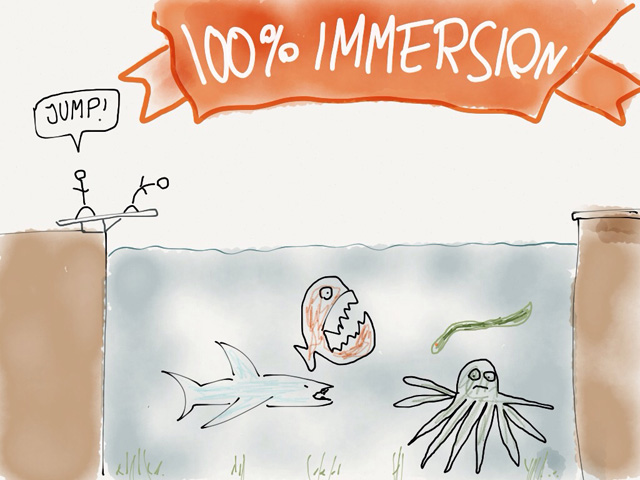Learning a language is a very personal endeavor. Each individual uses different ways to reach the same result: being able to communicate in a foreign language. But the road to success is paved with hardship and empty promises from “false prophets” eager to sell their one size fits all solutions.
1. The Instant Gratificator
This jolly old fellow loves to create language courses with glittering titles like “Flirt Fluently in Finnish in Only 10 days“, “Recite the Hebrew Bible Standing On One Leg in 4 Hours” or “Master German Grammar In Your Sleep”. Everyone knows that if you pick up a guitar for the first time and expect to sound like Eric Clapton, you’ll be slightly disappointed. Why should it be any different for learning a language?
Most of us aren’t polyglots. We’re struggling with spelling, pronunciation and grammar even in our mother tongue and for many native English speakers the difference between “their” and “they’re”, “its” and “it’s” – not to mention “I” and “me” seem to be nothing but an unfathomable mystery.
In other words, we all have a feeling that mastering a language is no push button business. This intuition doesn’t prevent us from looking for easy ways out, however. We simply want to believe – and that’s why we do. It’s this rather illogical but beautifully human characteristic which makes us buy into false advertising against our best reasoning. Especially when the going gets tough, when we’re sweating over conjugation tables and charts and don’t see any fruits to all that hard linguistic labor, we become susceptible to the snake oil of the Instant Gratificator.
2. The Goal Setter
The Goal Setter – not be confused with the Irish Setter – is a down-to-earth chap far removed from the blatantly childish promises of the Instant Gratificator. His shtick is deeply embedded into cultural thinking (at least in the West) and we’re all familiar with his simple solution to all life’s problems that “he who plans well does well“. In other words, you can do anything you want, but you need to set your goals and plan accordingly.
We’re all deeply infatuated with the Goal Setter. He doesn’t care about our age, dispositions or talent. In that sense, he’s deeply democratic. According to him, anyone can be a Shakespeare. You just have to set your goal and come up with an impeccable plan, say: write 1000 words per day, invent one new play every month, get recognized within one year, rake in good reviews, profit!
The beauty of the Goal Setter from a marketing standpoint is that he can profit all along while you’re still struggling with your daily, weekly and monthly goals. If he knows his game he’ll tell you to set simple goals for yourself until you reach them and then set even higher goals, i.e. you could start out by learning 10 new words per day, then proceed to 20, 50, 100 – the sky is the limit, right? You’ll get your gratification from reaching your intermediate goals and the Goal Setter gets the money.
It’s hard to point fingers at the Goal Setter. If we fail, our goals were simply too high, our plans too loose, our willpower to weak, etc. What we usually don’t consider is that reaching the sum of a number of intermediate learning goals doesn’t automatically turn into “language mastery”. You could collect a million tiny parts of a language, but if the “glue” is missing it all falls apart quickly. In the end, it’s not the quantity of goals that have been reached in a certain span of time but the overall quality of learning that counts.
3. The Gadget-o-Maniac
If there’s a false prophet in language teaching that is most characteristic for our times, than it’s this one: lover of all things gamy and blinking, herder of buzzwords and techno-babble: The Gadget-O-Maniac.
Since we’re already accustomed to his ways of thinking, we aren’t surprised to encounter him in the field of language learning. The way it usually works is this: We want to learn a language and start googling. On place one or two we find a paid advertising for a new method of language learning which is crowd-sourced, cloud-based and asynchronous. What does that mean? I don’t have a clue, either, but they sound as if they know what they’re talking about. Plus, it’s free and I get to add another app to my collection!
So I sign up for an account, confirm my email address and then it’s time to fill out my profile. “Oh wow, I get a badge for completing 100% of my profile, better follow through all the steps, then!” – “Sure I want to connect to my Facebook and Gmail and search for friends – hey look, that new girl from the office is on there, too…She looks cute on that profile picture, better add her as a friend…or maybe follow her…or … what’s the difference? … better do both and be on the safe side.” – “Now, let’s add some interests to my profile …What do I want to learn? … Basic Introduction, check … Conversation, check … Business Vocab, nah… Cinema & Literature, check … Okay, let’s start! … Wait, what plan do I want? … Premium or Free? Whatever, I just want to try this damn thing!”
The Gadget-o-Maniac is a master of disguise. He’ll steal your time and entangle you in enough irrelevant actions until you’ve completely forgotten what it was you wanted in the first place: learning a language. It can take a long time until you’ve disentangled yourself from its techno-tentacles. While you “engage” with some mind-numbing “interactive” program, clicking “yes” or “no”, solving multiple choice quizzes plastered with cute icons in a manner even laboratory Orangutans would scoff at, the Gadget-O-Maniac keeps you coming back with friendly “achievement unlocked” messages, daily email reminders and notifications straight to your mobile phone.
4. The Immersionist
This is a rare but increasingly popular species of language teaching. He pounces into the spotlight as a great liberator of language learners, urging us to free ourselves from the shackles of books, tear off the veils of grammar and exercises and leap stark naked into the wonders of “learning through experience”.
One might wonder how the Immersionist succeeds in selling his “method” – there are no products or courses to peddle, after all; but don’t be mistaken, this fellow knows how to turn water into whine. Instead of books there’ll be guided city tours, movie nights, flirtatious strolls and more. He’s the lifestyle artist, cosmopolitan culturist and connoisseur of cuisine and local club scenes.
The great advantage of this approach to language teaching is that any kind of everyday activity can easily be turned into a language learning opportunity. The underlying message here is that if you’ll live right you’ll learn right. Since many times learners of a certain language don’t reside in a country where this language is naturally spoken, the Immersionist is part tour-guide, part travel-agency, part entertainer.
There’s nothing to object against spending a week (all inclusive) on a Mediterranean island, lying on the beaches, rushing from party to party and meeting people from all over the world, except locals. It’s no crime to get drunk and gleefully confuse improvised words and gestures with language learning, but once the booze wears off and the budget runs dry, so does the illusion of being able to say more than “hello” and “thanks” in the target language.
5. The Mechanist

The Mechanist is the most traditional and well known false prophet in the world of language learning. He’s the one that taught you German and all you remember is a blackboard full of horrid rules and exceptions. He taught your granny Latin in high school, which she never really understood but still passed exceptionally because she learned everything by heart.
To the Mechanist, language is a great machine full of cogwheels, levers and springs. Mastering a language amounts to studying the manual of this great wondrous machine and being able to recite certain parts of it on command.
But he’s a dying breed. It’s almost impossible for him to market himself. Who would sign up eagerly for a course of hardcore grammar these days, if they have a choice? Why pay hard cold cash for lectures that do little else than torture the listener? No, you won’t usually find this fellow on the first page of Google’s search results.
We all remember his tables, charts and diagrams from school. We’ve become wary and can spot his approach a mile away. And while it is indeed strangely comforting to try and tame the beast of human communication in a straight jacket of neat rules and regulations, the Mechanist often not only fails in producing practical language skills in his students but sometimes even creates life-long feelings of resistance towards the target tongue.
UPDATE:
So what’s the right method to study a language, people have asked? Why did I portray perfectly valid approaches as “false” in this article? Of course none of them are in and of themselves bad, but neither is this article fully serious, of course (but you should know that already). The problem starts when a teacher or teaching product lifts one of these approaches on a pedestal and tries to sell it as the “one and only” way.
From my own experience as a language instructor I have learned that there is no “right way” to learn a language. For one person, immersion might be the way to go, for another one formal grammar study might be the best. In the end, however, each and everyone has to decide for themselves what works and what doesn’t. This article is just a little reminder that you shouldn’t take anyone’s word for it.
–
What are your favorite “false prophets” in language teaching? Add them in the comments, below!




